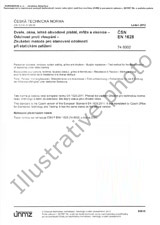We need your consent to use the individual data so that you can see information about your interests, among other things. Click "OK" to give your consent.
ČSN EN 14405 (838006)
Characterization of waste - Leaching behaviour test - Upflow percolation test (under specified conditions)
Translate name
STANDARD published on 1.11.2017
The information about the standard:
Designation standards: ČSN EN 14405
Classification mark: 838006
Catalog number: 502938
Publication date standards: 1.11.2017
SKU: NS-799461
The number of pages: 44
Approximate weight : 132 g (0.29 lbs)
Country: Czech technical standard
Category: Technical standards ČSN
The category - similar standards:
Annotation of standard text ČSN EN 14405 (838006):
This European Standard is applicable for determining the leaching behaviour of inorganic and non-volatile organic substances from granular waste (without or with size reduction (see 7.2)). The waste body is subjected to percolation with water as a function of liquid to solid ratio under specified percolation conditions. The waste is leached under hydraulically dynamic conditions. The method is a once-through column leaching test and the test results establish the distinction between different release patterns, for instance wash-out and release under the influence of interaction with the matrix, when approaching local equilibrium between waste and leachant. This test method produces eluates, which can subsequently be characterized by physical, chemical and ecotoxicological methods according to existing standard methods.
NOTE 1: The mentioned specified percolation conditions are arbitrary and are not necessarily simulating a specific scenario.
NOTE 2: Waste materials that show a saturated hydraulic conductivity between 10-7 m/s and 10-8 m/s can be subjected to this test, but it can be difficult to maintain the imposed flow rate. If a waste shows a saturated hydraulic conductivity below 10-8 m/s, the test will preferably not be carried out (See C.5 for a definition of ´hydraulic conductivity´).
NOTE 3: This procedure is generally not applicable to biologically degrading materials and materials reacting with the leachant, leading, for example, to excessive gas emission or excessive heat release.
NOTE 4: This procedure is applicable to materials showing solidification in the column, if the final hydraulic conductivity is within the specified range (see NOTE 2).
NOTE 5: It is not always possible to optimise test conditions simultaneously for inorganic and non-volatile organic substances and optimum test conditions may also vary between different groups of non-volatile organic substances. Test requirements for non-volatile organic substances are generally more stringent than those for inorganic constituents. The test conditions suitable for measuring the release of non-volatile organic substances will generally also be applicable to inorganic substances.
NOTE 6: For ecotoxicological testing, eluates representing the release of both inorganic and non-volatile organic substances are needed. In this standard ecotoxicological testing is meant to include also genotoxicological testing.
NOTE 7: Validation data for non-volatile organic substances are not currently available, but will be added on revision when available
Preview of the standard ČSN EN 14405 (838006)
We recommend:
Technical standards updating
Do you want to make sure you use only the valid technical standards?
We can offer you a solution which will provide you a monthly overview concerning the updating of standards which you use.
Would you like to know more? Look at this page.




 Cookies
Cookies
